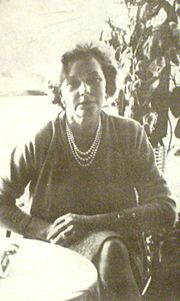Silvina Bullrich facts for kids
Quick facts for kids
Silvina Bullrich
|
|
|---|---|
 |
|
| Born | October 4, 1915 Buenos Aires |
| Died | July 2, 1990 (aged 74) Geneva |
| Resting place | Jardín de Paz Cemetery Pilar, Buenos Aires |
| Occupation | Novelist, professor and translator of French literature |
| Language | Spanish |
| Period | 1939–86 |
| Genre | Modernist literature |
| Notable awards | Municipal Prize - Literature (1961) National Prize - Literature (1972) |
Silvina Bullrich (born October 4, 1915, died July 2, 1990) was a very popular writer from Argentina. She wrote many novels that sold well. She also worked as a translator, wrote movie scripts, and was a literary critic. In Argentina, people sometimes called her la gran burguesa, which means "the great lady of the middle class."
| Top - 0-9 A B C D E F G H I J K L M N O P Q R S T U V W X Y Z |
Early Life and Education
Silvina Bullrich was born in Buenos Aires. Her mother, María Laura Meyrelles de Bullrich, had Portuguese family. Her father, Rafael Bullrich, was a well-known heart doctor and a dean at the University of Buenos Aires.
Silvina was the second of three sisters. She grew up in a wealthy family. Her mother loved classic books and often took her daughters to Paris. Silvina did not go to university, but she earned a diploma in French language studies from the Buenos Aires Alliance Française.
Starting Her Writing Career
In 1936, Silvina married Arturo Palenque. They had one son. Silvina focused on her writing. She wrote book reviews for La Nación, a big newspaper in Argentina.
In 1939, she published a collection of poems called Vibraciones. She also published Calles de Buenos Aires ("Streets of Buenos Aires") in Atlántida magazine.
She became friends with famous writers Adolfo Bioy Casares and Jorge Luis Borges. In 1945, she worked with Borges on a book of stories called El compadrito ("The Poseur").
Silvina's early writing years were also a challenging time in her life. She faced personal difficulties, which later influenced her stories. Many of her books showed young women from comfortable backgrounds dealing with difficult relationships and money problems.
Becoming a Famous Novelist
Silvina's book Historia de un silencio ("History of a Silent Moment") came out in 1949. This novel, set in Tigre, helped her become well-known in the Argentine writing world.
Her next books, Bodas de cristal ("Crystal Jubilee," 1951) and Telefono ocupado ("Busy Signal," 1956), continued to explore private feelings. Her characters often thought about and criticized unfair male attitudes or weak traits in women. "Crystal Jubilee" was her first big commercial success.
In 1956, Silvina married Marcelo Dupont. This was a happy time for her, but it ended when Marcelo sadly passed away from a sudden illness that same year.
Awards and New Directions
Silvina Bullrich won the Municipal Literary Prize in 1961 for her books El hechicero ("The Sorcerer") and Un momento muy largo ("A Lasting Moment").
She also taught French literature at the National University of La Plata. In 1962, she was asked to turn a French novel, Les Filles de joie ("Daughters of Happiness"), into an Argentine film. Her book "A Lasting Moment" was also made into a movie in 1964, with Silvina writing the script.
In 1964, she wrote Los burgueses ("The Bourgeoisie"). This was her first book to talk about social issues in Argentina. It sold about 60,000 copies in Argentina and was translated into many languages.
Continued Success and Important Themes
Many of Silvina's other novels sold around 100,000 copies. Her book Mañana digo basta ("Tomorrow I'll Say, Enough!"), published in 1968, was praised as a strong argument for women's rights.
El mundo que yo vi ("The World I Saw," 1969) was a popular book about her many trips through Europe and Asia. Her book Los pasajeros del jardín ("Wanderers in the Garden") was a touching story about her marriage to Marcelo Dupont. It won her a National Literary Prize in 1972.
Her ongoing success led to a 1975 film based on her novel "Crystal Jubilee," for which she wrote the screenplay. Silvina continued to write about important national problems. In 1976, she published Será justicia ("There Will Be Justice"), which looked at Argentina's complicated legal system. This book was her last widely praised work. After this, she wrote less controversial novels, still including her views on women's rights, and her memoirs, published in 1980.
Later Years and Legacy
Silvina Bullrich translated many works into Spanish. These included books by famous writers like Simone de Beauvoir, Graham Greene, and George Sand. She also wrote a biography about George Sand in 1946.
In 1984, she contributed to a well-known documentary called Eva Perón: quien quiera oír que oiga ("Listen if You Want"). Even though she wasn't a supporter of Peronism, her comments showed how important Eva Perón was for women in Argentina.
Silvina remained close friends with Jorge Luis Borges. She visited him in Geneva shortly before he passed away in 1986. That same year, she published her last book, La bicicleta. This book commented on Argentina's recent financial problems. "The bicycle" is also a slang term in Argentina for moving money around to pay one debt with another.
Silvina Bullrich had been a smoker for a long time and developed lung cancer. She moved to Geneva for special medical care and passed away there in 1990. She was buried in the Jardín de Paz cemetery in Pilar, Buenos Aires.
See also
 In Spanish: Silvina Bullrich para niños
In Spanish: Silvina Bullrich para niños
- Lists of writers

